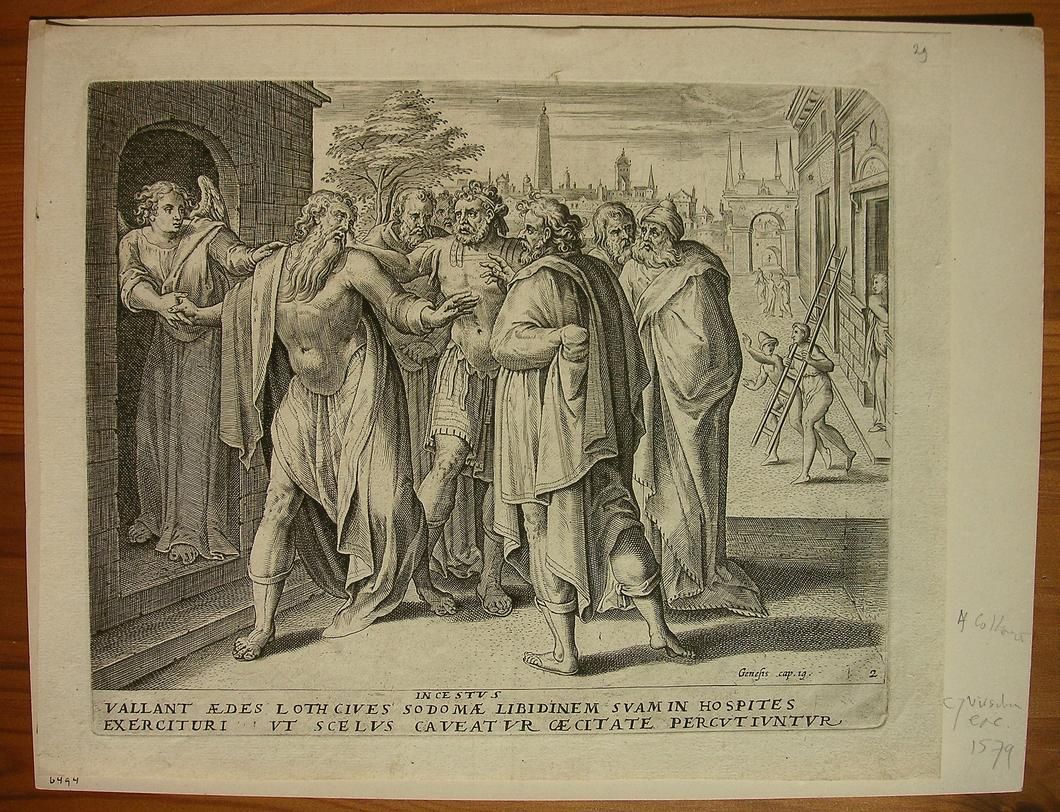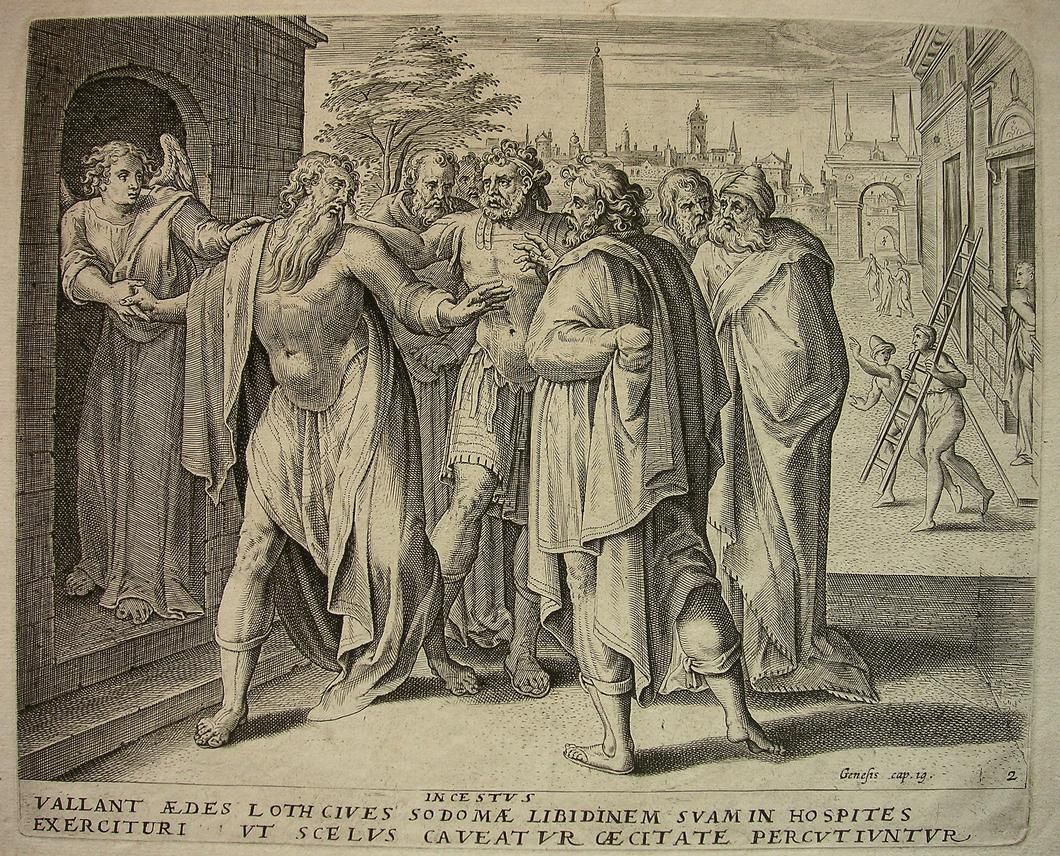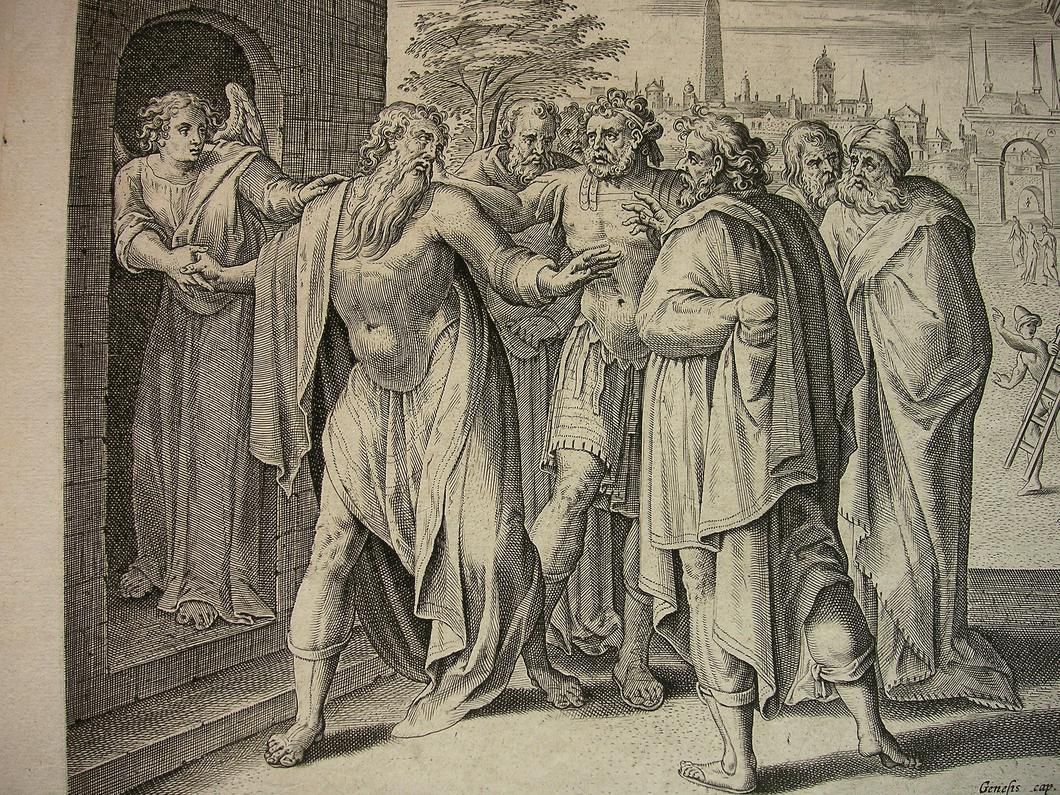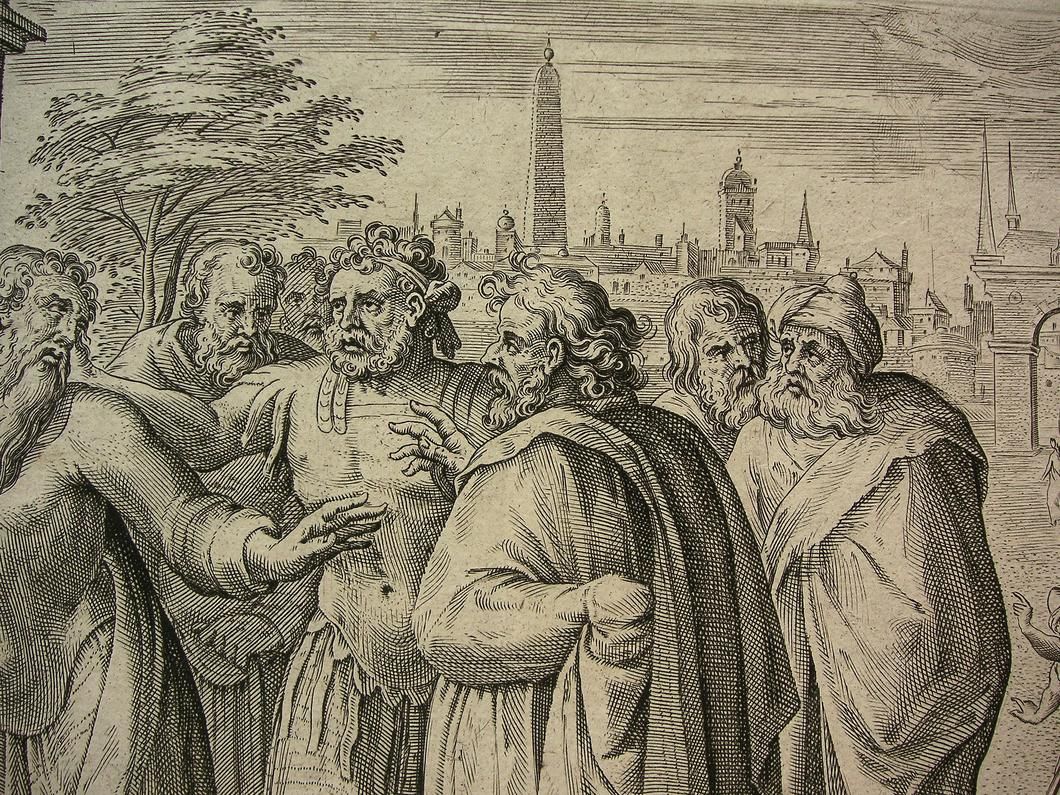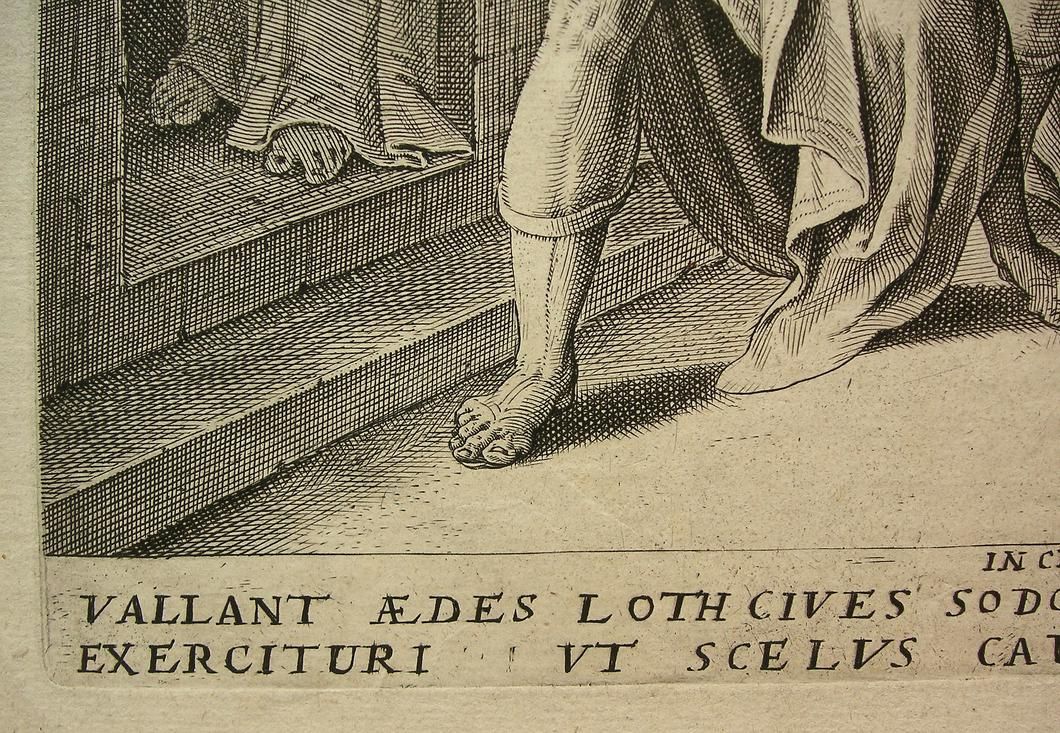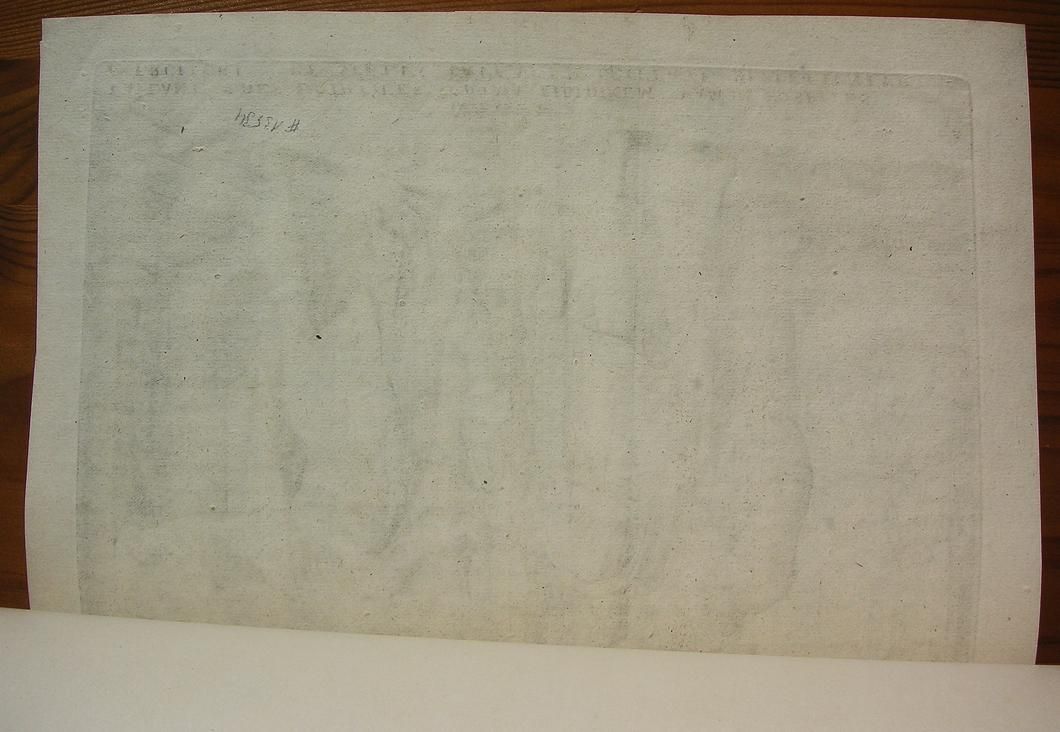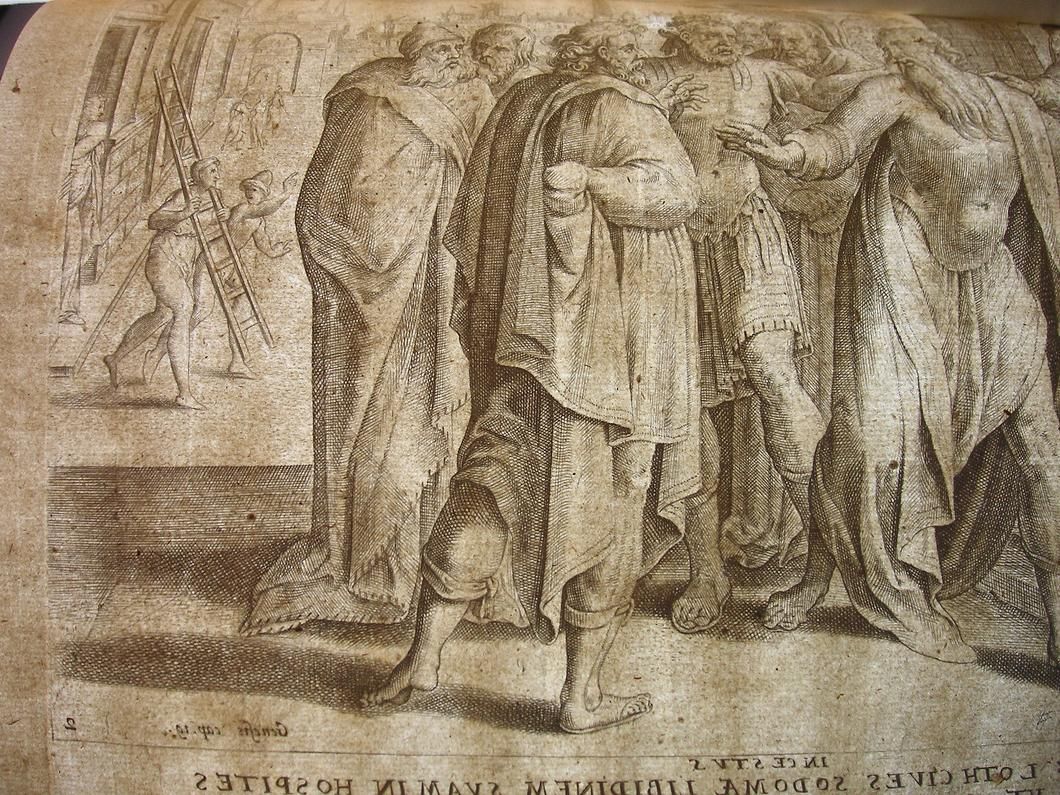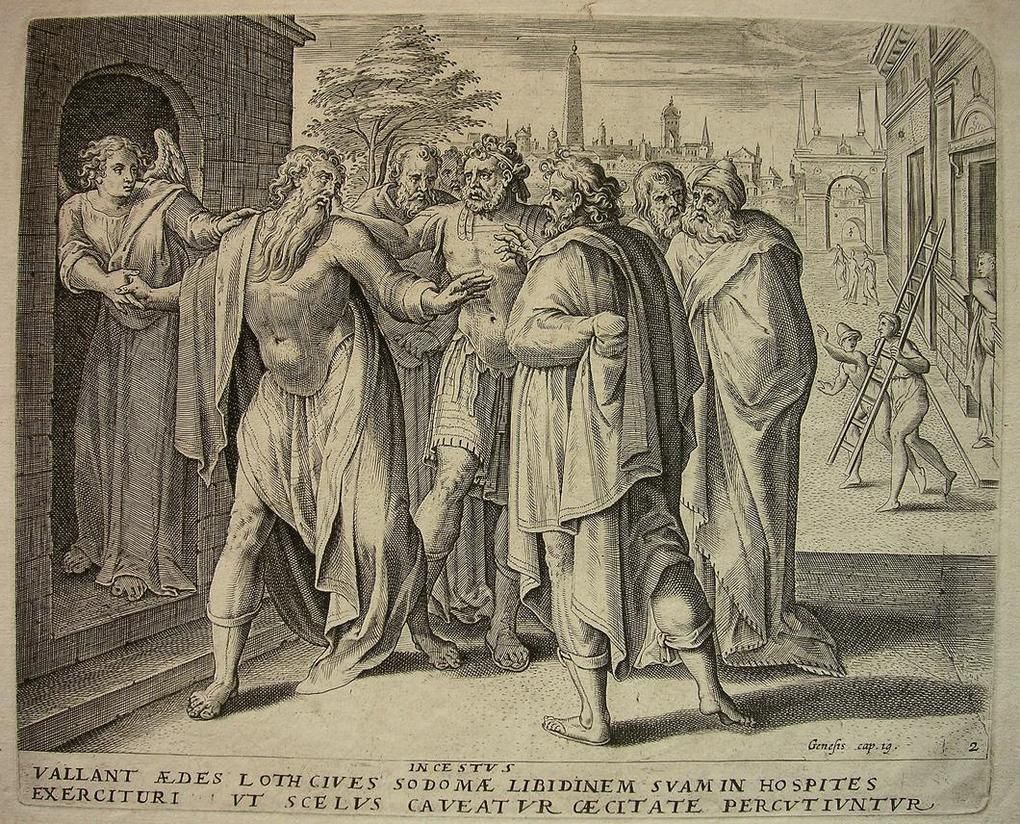
`Incestus´
`VALLANT AEDES LOTH CIVES....EXERCITURI......´
`Genesis cap. 19.; 2´
Blatt/ sheet: 24,0 x 28,9 cm
Platte/ plate: 20,8 x 25,4 cm
Die Leute aus Sodom umstellen Lot(h)s Haus.
Lot(h) beschützt den Engel.
Kupferstich eines anonymen Künstlers nach Frans Menton (um 1550-1615) und
Jan Snellinck (1548-1638) (Zuschreibung, ab dem 3. Zustand!), Nr. 2 von 4 aus
'Die Geschichte des Lot(h)' (NH 32-35, de Jode), im 5. Zustand (von 5), mit
der Änderung in 'EXERCITURI' von zuvor 'EXERCITATURI', bei
C. J. Visscher (1587-1652), ab 1643.
Der Kupferstich, um 1550-1570 nach Vorlage Mentons entstanden, mit
Zuschreibung an Hans Collaert (I) (ca. 1530-1580) (Jan Collaert I,
Johannes Collaert), erfuhr zahlreiche Überarbeitungen, ab dem 3. Zustand
durch einen anonymen Künstler nach Vorlage Snellincks (Zuschreibung),
siehe Leesberg (New Hollstein, de Jode, 2018).
Referenz:
- Leesberg (New Hollstein, de Jode), Bd. 1, (2018), S. 40ff., Nr. 33 V (V);
- Diels/Leesberg (New Hollstein, Collaert), Bd. 1, (2005), S. 33., Nr. 23 II (II);
- Harvard Art Museums, Nr. 2011.613.21 (3. Zustand, 1579);
- Rijksmuseum, Nr. RP-P-1882-A-6396 (1. Zustand);
- Rijksmuseum, Nr. RP-P-1878-A-1283 (2. Zustand);
- Rijksmuseum, Nr. RP-P-1995-25-30 (3. Zustand, 1579)
- Rijksmuseum, Nr. RP-P-1904-3470 (4. Zustand, 1639)
- Rijksmuseum, Nr. RP-P-1976-30-32 (5. Zustand, ab 1643).
Ausgezeichneter Abdruck mit Plattenton auf Bütten mit Wasserzeichen
(Narrenkappe mit sieben Halsschellen) und Rand um die Plattenkante.
Eine schwache vertikale Faltung, ein kl. Mangel an der oberen Platten-
kante, oben re. in Bleistift nummeriert. Mit den oberen Ecken auf
Trägerkarton geklebt, sonst schön.
Photos s.u. sowie o. li. (HR).
The People of Sodom Surounding Lot's House.
Lot Protecting the Angel.
Engraving by an anonymous artist after Frans Menton (c1550-1615) and
Jan Snellinck (1548-1638) (attributed, 3. state onwards), No. 2 of 4 from
'The Story of Lot' (NH 32-35, de Jode), in 5. state (of 5), the title revised
to 'EXERCITURI' from 'EXERCITATURI', published by C. J. Visscher
(1587-1652), 1643.
Attributed to Hans Collaert (I) (c. 1530-1580) (Jan Collaert I) around
1550-1570 after an invention by Frans Menton, the plate was reworked
several times, by an anonymous artist after Snellinck's invention (attrib.)
from the 3. state onwards, cf. Leesberg (New Hollstein, de Jode, 2018).
Reference:
- Leesberg (New Hollstein, de Jode), Vol. 1, (2018), p. 40ff., No. 33 V (V);
- Diels/Leesberg (New Hollstein, Collaert), Vol. 1, (2005), p. 33., No. 23 II (II);
- Harvard Art Museums, No. 2011.613.21 (3. state, 1579);
- Rijksmuseum, No. RP-P-1882-A-6396 (1. state);
- Rijksmuseum, No. RP-P-1878-A-1283 (2. state);
- Rijksmuseum, No. RP-P-1995-25-30 (3. state, 1579)
- Rijksmuseum, No. RP-P-1904-3470 (4. state, 1639)
- Rijksmuseum, No. RP-P-1976-30-32 (5. state, 1643).
Excellent impression on laid paper with watermark (Foolscap, with seven
points collar) and margins. A weak vertical fold; a tiny flaw to upper edge
of plate, numbered in pencil at top right. Glued to support with upper
corners, else nice.
Photos below and top left. (HR).
`VALLANT AEDES LOTH CIVES....EXERCITURI......´
`Genesis cap. 19.; 2´
Blatt/ sheet: 24,0 x 28,9 cm
Platte/ plate: 20,8 x 25,4 cm
Die Leute aus Sodom umstellen Lot(h)s Haus.
Lot(h) beschützt den Engel.
Kupferstich eines anonymen Künstlers nach Frans Menton (um 1550-1615) und
Jan Snellinck (1548-1638) (Zuschreibung, ab dem 3. Zustand!), Nr. 2 von 4 aus
'Die Geschichte des Lot(h)' (NH 32-35, de Jode), im 5. Zustand (von 5), mit
der Änderung in 'EXERCITURI' von zuvor 'EXERCITATURI', bei
C. J. Visscher (1587-1652), ab 1643.
Der Kupferstich, um 1550-1570 nach Vorlage Mentons entstanden, mit
Zuschreibung an Hans Collaert (I) (ca. 1530-1580) (Jan Collaert I,
Johannes Collaert), erfuhr zahlreiche Überarbeitungen, ab dem 3. Zustand
durch einen anonymen Künstler nach Vorlage Snellincks (Zuschreibung),
siehe Leesberg (New Hollstein, de Jode, 2018).
Referenz:
- Leesberg (New Hollstein, de Jode), Bd. 1, (2018), S. 40ff., Nr. 33 V (V);
- Diels/Leesberg (New Hollstein, Collaert), Bd. 1, (2005), S. 33., Nr. 23 II (II);
- Harvard Art Museums, Nr. 2011.613.21 (3. Zustand, 1579);
- Rijksmuseum, Nr. RP-P-1882-A-6396 (1. Zustand);
- Rijksmuseum, Nr. RP-P-1878-A-1283 (2. Zustand);
- Rijksmuseum, Nr. RP-P-1995-25-30 (3. Zustand, 1579)
- Rijksmuseum, Nr. RP-P-1904-3470 (4. Zustand, 1639)
- Rijksmuseum, Nr. RP-P-1976-30-32 (5. Zustand, ab 1643).
Ausgezeichneter Abdruck mit Plattenton auf Bütten mit Wasserzeichen
(Narrenkappe mit sieben Halsschellen) und Rand um die Plattenkante.
Eine schwache vertikale Faltung, ein kl. Mangel an der oberen Platten-
kante, oben re. in Bleistift nummeriert. Mit den oberen Ecken auf
Trägerkarton geklebt, sonst schön.
Photos s.u. sowie o. li. (HR).
The People of Sodom Surounding Lot's House.
Lot Protecting the Angel.
Engraving by an anonymous artist after Frans Menton (c1550-1615) and
Jan Snellinck (1548-1638) (attributed, 3. state onwards), No. 2 of 4 from
'The Story of Lot' (NH 32-35, de Jode), in 5. state (of 5), the title revised
to 'EXERCITURI' from 'EXERCITATURI', published by C. J. Visscher
(1587-1652), 1643.
Attributed to Hans Collaert (I) (c. 1530-1580) (Jan Collaert I) around
1550-1570 after an invention by Frans Menton, the plate was reworked
several times, by an anonymous artist after Snellinck's invention (attrib.)
from the 3. state onwards, cf. Leesberg (New Hollstein, de Jode, 2018).
Reference:
- Leesberg (New Hollstein, de Jode), Vol. 1, (2018), p. 40ff., No. 33 V (V);
- Diels/Leesberg (New Hollstein, Collaert), Vol. 1, (2005), p. 33., No. 23 II (II);
- Harvard Art Museums, No. 2011.613.21 (3. state, 1579);
- Rijksmuseum, No. RP-P-1882-A-6396 (1. state);
- Rijksmuseum, No. RP-P-1878-A-1283 (2. state);
- Rijksmuseum, No. RP-P-1995-25-30 (3. state, 1579)
- Rijksmuseum, No. RP-P-1904-3470 (4. state, 1639)
- Rijksmuseum, No. RP-P-1976-30-32 (5. state, 1643).
Excellent impression on laid paper with watermark (Foolscap, with seven
points collar) and margins. A weak vertical fold; a tiny flaw to upper edge
of plate, numbered in pencil at top right. Glued to support with upper
corners, else nice.
Photos below and top left. (HR).
Rechtliche Informationen s.u.
